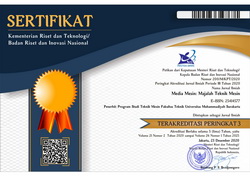Use the provided template to write an article. The template has all the styles needed for writing. Save your article in *.doc format. Do not use *.docx or *.pdf format, so that it will be easier to edit the paper for reviewing and editing purpose.
ABSTRACT AND KEYWORDS
An abstract contains summary of the Introduction, summary of Methods, summary of Result and Discussion, and summary of Conclusion. The number of words in the abstract is limited to 200 – 300 words and are written in Times New Roman, 12, Italic. Keywords contain key scientific terms that are used in an article. Use 3 – 5 words or terms that are common in the field of mechanical engineering.
INTRODUCTION SECTION
Introduction section may contain description about problems that are studied in a research. It may contain arguments why the topic raised in the writing is important. Give proper number of citations for descriptions in the Introduction. Literature review may be included in this section where necessary. Research aim, writing systematics and summary of conclusion may be included here as well.
OTHER SECTIONS
The other sections may consist of Mathematical Model, Methods, Result, Discussion or any other section if considered necessary. The sections may contain descriptions of how data were obtained, which algorithms or formulations were used in the research, how data were processed, and how the results were evaluated. The sections may contain formula, tables and/or figures. Any formula, table and figure must be refered to in the description.
CONCLUSION
Conclusion section summarizes the descriptions written in Results and Discussion section. Acknowledment may be written prior to Conclusion.
CITATION AND BIBLIOGRAPHY
This journal uses IEEE citation style [1]. In-text citations are written using arabic numbers inside square brackets and are ordered by their occurrence in the writing [2]. We encourage the use of reference/citation manager such as Mendeley or Zotero when writing your article [3]–[5]. Open-source reference manager are available to use without charge or with a small cost [4],[6].
EXAMPLE OF BIBLIOGRAPHY LIST
[1] C. Leacock and M. Chodorow, “Combining local context and WordNet similarity for word sense identification,” in WordNet, An Electronic Lexical Database, The MIT Press, 1998.
[2] M. E. Lesk, “Automatic Sense Disambiguation Using Machine Readable Dictionaries: How to Tell a Pine Cone from an Ice Cream Cone,” in Proceedings of SIGDOC Conference, 1986.
[3] B. Liu and L. Zhang, “A survey of opinion mining and sentiment analysis,” in Mining Text Data, 2012, pp. 415–463.
[4] C. C. Aggarwal and C. Zhai, “A survey of Text Classification Algorithms,” in Mining Text Data, Springer US, 2012, p. 533.
[5] G. Song, Y. Ye, X. Du, X. Huang, and S. Bie, “Short Text Classification: A Survey,” J. Multimed., vol. 9, no. 5, pp. 635–643, 2014.
[6] C. D. Manning, P. Raghavan, and H. Schultze, Introduction to Information Retrieval. Cambridge University Press, 2009.








